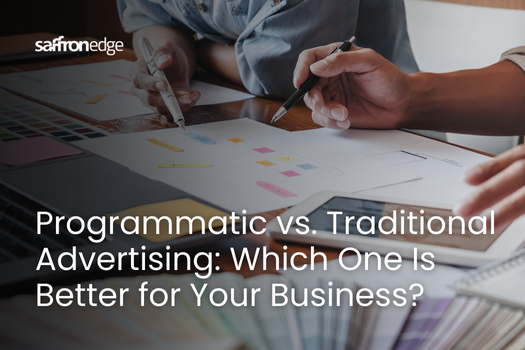Programmatic vs. Traditional Advertising: Which One Delivers Better Results?
Table of contents
Have you ever wondered whether traditional advertising still holds its ground in today's digital-first world? Is programmatic advertising truly the future, or is it just another marketing buzzword?
The numbers tell an interesting story. According to IAB Australia, advertisers have significantly increased their investment in digital advertising, with total spending reaching $15.6 billion in the last financial year—a 9.7% increase from the previous year.
The surge is mainly driven by video advertising, particularly Connected TV (CTV), which now accounts for 55% of video ad spending.
Meanwhile, traditional media channels are declining. Advertisers are reallocating budgets as more consumers shift to on-demand and streaming services.
So, what does this mean for businesses? Should you use traditional advertising, embrace programmatic, or adopt a hybrid approach? Let's break down both advertising models' key differences, advantages, and challenges.
Programmatic vs. Traditional Advertising: Why you should understand this?
Advertising is no longer just about placing ads on billboards or negotiating TV slots. The shift from traditional to programmatic advertising transforms how businesses reach their audience with precision and efficiency.
But what’s the difference, and why does it matter? Understanding these two approaches can help you make smarter marketing decisions and maximize your ad spend.
1. Automation vs. Manual Buying
Traditional advertising requires manual negotiations, fixed pricing, and direct deals with publishers. In contrast, programmatic advertising automates this process using AI and real-time bidding, making ad buying faster, more efficient, and cost-effective.
2. Targeting & Personalization
Traditional ads cast a wide net, often reaching a broad audience with little personalization. Programmatic advertising, on the other hand, leverages data to target the right audience at the right time, ensuring better engagement and higher ROI.
3. Cost & Performance Measurement
With traditional advertising, measuring success can be challenging. Programmatic advertising provides real-time analytics, allowing marketers to track impressions, clicks, and conversions instantly, optimizing campaigns for maximum impact.
By understanding the differences, businesses can make informed decisions about their advertising strategy and blend both approaches for optimal results.
Programmatic vs. Traditional Advertising: A Quick Comparison
Programmatic and traditional advertising are two different approaches to reaching your audience. While traditional advertising relies on manual placements, programmatic uses automation and data for more precise targeting and efficiency.
| Feature | Programmatic Advertising | Traditional Advertising |
|---|---|---|
| Buying Process | Automated using AI & real-time bidding | Manual negotiations & direct deals |
| Targeting | Data-driven, precise audience targeting | Broad, less personalized targeting |
| Speed | Instant ad placements & adjustments | Slow, requires manual approvals |
| Cost Efficiency | Optimized spend with real-time bidding | Fixed pricing, often higher costs |
| Personalization | Highly personalized ads based on user behavior | One-size-fits-all messaging |
| Performance Tracking | Real-time analytics & campaign optimization | Difficult to measure ROI accurately |
| Ad Placement | Display, social, video, native, CTV, and more | TV, radio, print, billboards, and some digital |
| Flexibility | Easily scalable & adjustable mid-campaign | Limited flexibility once the campaign is set up |
What is Traditional Marketing?
Traditional advertising refers to marketing methods that have been used for decades. It leverages offline media channels such as television, radio, newspapers, magazines, billboards, and direct mail.
These forms of advertising were the dominant methods of brand promotion before the digital revolution and still play a significant role in marketing strategies today.
Despite the rise of digital platforms, traditional advertising remains valuable, especially for brands targeting mass audiences, local consumers, or specific industries.
Key Characteristics of Traditional Advertising:
Mass Audience Reach
One of traditional advertising's biggest strengths is its ability to reach a broad audience simultaneously. This makes it particularly effective for brand awareness campaigns, which aim to expose a brand, product, or message to as many people as possible.
Examples:
-
Television Commercials: A 30-second ad aired during prime-time television or a major event, like the Super Bowl, can reach millions of viewers at once.
-
Radio Advertising: A radio ad played during a popular morning show reaches commuters who listen to the station daily.
-
Billboards: A large billboard placed in a high-traffic area (e.g., Times Square or a major highway) is seen by thousands daily.
Limitations:
-
Although traditional advertising reaches a wide audience, it cannot segment and target specific individuals based on their interests, behaviours, or purchasing habits.
-
Advertisers cannot control who sees the ad, making it less efficient than digital alternatives offering precise targeting.
Static Content
Once published or aired, traditional advertising materials cannot be changed until the next campaign cycle. Unlike digital ads, which can be edited in real-time, traditional advertisements have a fixed format and lifespan.
Examples:
-
Print Ads in Magazines/Newspapers: If an ad contains an error or a company wants to change its messaging, it must wait for the next issue to be printed.
-
Billboards: Once a billboard is put up, it remains unchanged for weeks or months unless replaced with a new design.
-
TV and Radio Commercials: Production and placement require a significant investment, so making changes mid-campaign is costly and time-consuming.
Limitations:
-
Lack of flexibility makes updating or adjusting ads in response to market trends or consumer feedback difficult.
-
If a competitor launches a new campaign, traditional advertisers cannot react quickly and must wait until the next advertising slot.
Limited Targeting
While traditional advertising allows for some demographic targeting, it is nowhere near as precise as digital advertising, which uses behavioural data, interests, and real-time analytics to reach specific audiences.
Targeting in Traditional Advertising:
-
TV and Radio Advertising: Marketers choose programs or time slots based on their audience demographics. For example, a luxury car brand may advertise during a financial news segment, assuming viewers have high purchasing power.
-
Print Advertising: Advertisers select publications based on readership demographics. A fashion brand might choose to place ads in Vogue, knowing its readers are fashion-conscious.
-
Billboards: While location-based targeting exists, it is still broad. A billboard in an upscale neighbourhood might attract affluent consumers but cannot target individuals based on their online behaviours or interests.
Limitations:
-
Traditional advertising cannot track audience engagement or ensure the message reaches only the most relevant consumers.
-
Ad waste is higher since many people who see the ad may have no interest in the product or service.
Manual Processes
Buying, placing, and managing traditional ads is largely manual and involves negotiations, paperwork, and human intervention.
How Traditional Ad Buying Works:
-
TV/Radio: Advertisers must contact the station, negotiate pricing, and book time slots in advance.
-
Print Media: Marketers work with newspaper/magazine publishers, select ad sizes, and submit creative materials before the print deadline.
-
Billboards: Securing a billboard location involves working with an outdoor advertising company, signing contracts, and producing physical materials.
Limitations:
-
Traditional ad placements lack marketing automation, making the process slow and labor-intensive compared to programmatic advertising, which uses AI to automate ad buying in real time.
-
Advertisers cannot adjust bids, pause campaigns, or optimize based on real-time performance.
Maximize Conversions with Smarter Paid Advertising
Leverage AI-driven targeting and real-time bidding to optimize ad spend, reach the right audience, and boost ROI effortlessly.
What is Programmatic Advertising?
Programmatic advertising is a technology-driven approach to buying and selling digital ad space in real-time.
Unlike traditional advertising, where placements require manual negotiations and contracts, programmatic advertising automates the process using Artificial Intelligence (AI), machine learning, and real-time bidding (RTB).
This allows advertisers to reach highly specific audiences with personalized messaging across websites, social media, mobile apps, and other digital platforms.
Because programmatic advertising relies on data and automation and paid marketing strategies, it enables advertisers to optimize campaigns dynamically, improve cost efficiency, and ensure that ads are delivered to the most relevant audience at the right time.
Key Characteristics of Programmatic Advertising
Automation
Traditional ad placements require human involvement in negotiating prices, choosing placements, and finalizing deals with media companies.
In contrast, programmatic advertising automates this process using AI, allowing advertisers to quickly and efficiently purchase ad space in milliseconds.
How Automation Works in Programmatic Advertising:
-
Advertisers set specific targeting parameters, such as age, gender, interests, location, browsing behaviour, and device type.
-
AI-driven algorithms analyze user data in real-time to determine the most relevant audience for the ad.
-
Ads are placed instantly on the most suitable digital platforms without manual intervention.
Advantages:
-
Speeds up the ad placement process, reducing human workload.
-
Increases efficiency by matching ads to the right audience automatically.
-
Allows advertisers to scale campaigns quickly across multiple platforms, including social media advertising.
Precision Targeting
One of the biggest advantages of programmatic advertising is its ability to target users with extreme accuracy.
Unlike traditional advertising, where brands reach broad, general audiences, programmatic advertising ensures that ads are displayed only to users who are most likely to be interested.
How Precision Targeting Works:
-
Demographics (age, gender, income level, education, etc.)
-
Geolocation (country, city, neighbourhood, or even specific locations like airports)
-
Behavioral Data (browsing history, purchase intent, engagement patterns)
-
Interests and Preferences (hobbies, favourite brands, lifestyle choices)
Advantages:
-
Eliminates ad waste by ensuring ads are shown only to relevant users.
-
Increases engagement rates, click-through rates (CTR), and conversions.
-
Helps businesses maximize their ad budget by focusing on high-intent audiences.
Real-Time Analytics:
Traditional advertising lacks real-time performance tracking, making it difficult for businesses to measure how well their campaigns are performing.
In contrast, programmatic advertising provides instant access to detailed analytics, allowing advertisers to make data-driven decisions on the fly.
What Real-Time Analytics Measures:
-
Impressions: Number of times an ad was displayed.
-
Click-Through Rate (CTR): Percentage of users who clicked the ad.
-
Conversion Rate: How many users took the desired action (e.g., signing up, purchasing).
-
Audience Engagement: How long have users interacted with the ad content?
Advantages:
-
Optimizes ad spend by shifting budgets to high-performing audiences.
-
Helps advertisers A/B test different ad creatives, headlines, and targeting strategies.
-
Provides instant insights into what’s working and what’s not, reducing wasted spend.
Cost Efficiency
Programmatic advertising is cost-efficient because it uses real-time bidding (RTB) to ensure advertisers only pay the optimal price for ad placements. This differs from traditional advertising, where ad space is purchased at fixed rates regardless of performance.
How Real-Time Bidding (RTB) Works:
-
When a user visits a website or app, an instant auction takes place in milliseconds.
-
Advertisers bid on the available ad space based on how valuable that user is to them.
-
The highest bidder wins the placement, and their ad is shown to the user.
Advantages:
-
Ensures advertisers pay the lowest possible price for high-quality placements.
-
Reduces wasted ad spend by avoiding irrelevant impressions.
-
Increases return on investment (ROI) by focusing on the most valuable users.
Detailed Comparison: Programmatic vs. Traditional Advertising
When choosing an advertising strategy, businesses must consider factors such as targeting precision, flexibility, cost-efficiency, and performance tracking.
Traditional and programmatic advertising differ significantly in these aspects, making understanding their strengths and limitations essential. Below is a detailed comparison of how these two models function across key parameters.
Targeting Capabilities
-
Traditional Advertising: Traditional advertising targets audiences based on the general demographics of a particular medium (TV, radio, print, billboards). This means that advertisers have limited control over who actually sees their ads.
-
Broad audience approach—ads are shown to many people who may not be relevant to the brand.
-
Limited personalization—the same ad is displayed to everyone, regardless of their preferences or behaviours.
-
Lower engagement rates due to lack of precise targeting.
-
Programmatic Advertising: Programmatic advertising relies on real-time user data to ensure ads are shown to the right audience, at the right time, and on the right platform. Instead of broad targeting, advertisers use demographics (age, gender, income, etc.), behavioural data (past searches, website visits, purchase history), location-based targeting and interest-based targeting (e.g., fitness, fashion, travel)
-
Ensures ads reach only users who are most likely to be interested.
-
Reduces ad spend waste by avoiding irrelevant audiences.
-
Higher engagement and conversion rates due to precise targeting.
Flexibility and Adaptability
-
Traditional Advertising: Traditional advertising campaigns are fixed—once they are launched, making changes is difficult and costly.
-
No real-time updates—ads run as planned, regardless of changing circumstances.
-
Delayed response to market trends—if consumer behaviour shifts, advertisers cannot adjust their messaging immediately.
-
Costly revisions—modifying a billboard or print ad requires reprinting or redesigning, which adds expenses.
-
Programmatic Advertising: Programmatic advertising offers real-time flexibility, allowing advertisers to modify campaigns instantly based on: performance data (click-through rates, conversions, engagement), market trends (seasonal demand, viral trends, competitor activities) and audience feedback
-
Real-time campaign adjustments ensure optimal ad performance.
-
Lower costs since advertisers can pause or change ads instantly without significant financial losses.
-
Greater responsiveness to consumer behaviour and emerging trends.
Cost Implications
-
Traditional Advertising: Traditional advertising often requires large upfront investments due to high production costs (e.g., TV commercials, billboard designs, print layouts), fixed placement fees (e.g., paying for a 30-second TV spot, regardless of how many people engage) and ad wastage (ads are shown to many irrelevant users).
-
High upfront costs make it inaccessible for many businesses.
-
No guaranteed return on investment (ROI)—advertisers pay for placement, not results.
-
Difficult to optimize spend because targeting is broad and inflexible.
-
Programmatic Advertising: Programmatic advertising is more cost-efficient because it uses automated bidding systems to ensure advertisers only pay for relevant impressions.
Real-time bidding (RTB) ensures advertisers get the best prices for ad placements. Performance-based pricing means brands can adjust their budgets based on what’s working. Lower ad wastage since ads are only shown to relevant users.
-
Lower costs due to automated bidding and precise targeting.
-
Higher ROI as every ad impression is strategically placed.
-
Smaller budgets can be effective, making it ideal for startups and small businesses.
Measurability and Analytics
-
Traditional Advertising: Measuring the impact of traditional advertising relies on estimates and surveys, making it less precise than digital methods.
-
No real-time insights—advertisers have to wait for post-campaign analysis.
-
Difficult to attribute results directly to a specific ad.
-
Limited optimization opportunities since changes cannot be made mid-campaign.
-
Programmatic Advertising: Programmatic advertising provides real-time, data-driven analytics, allowing advertisers to track impressions, clicks, and conversions, engagement levels and attribution models.
-
Detailed performance metrics are available in real time.
-
Easier to measure ROI since advertisers can track user actions.
-
Continuous optimization based on live data.
Conclusion
As the digital marketing landscape evolves, businesses must embrace data-driven advertising strategies to stay competitive. While traditional advertising still holds value for brand awareness, it lacks the precision, flexibility, and cost-efficiency that modern marketers require.
Traditional advertising offers broad reach and is effective for mass-market campaigns, while programmatic advertising provides precision, flexibility, and real-time insights, making it ideal for targeted marketing efforts.
This is where Saffron Edge stands out as a leading digital marketing agency, helping businesses harness the full potential of programmatic advertising. With years of expertise in data-driven marketing, AI-powered targeting, and automated ad placements, Saffron Edge provides tailored programmatic solutions that drive measurable results.
Frequently Asked Questions
What is the main difference between programmatic and traditional advertising?
Programmatic advertising uses AI and automation to buy and place ads in real time, ensuring precise audience targeting and cost efficiency. Traditional advertising, on the other hand, relies on manual ad placements across TV, print, radio, and billboards, offering broad but less targeted reach.
Why is programmatic advertising more cost-effective than traditional advertising?
Programmatic advertising reduces wasted ad spend by using real-time bidding (RTB) and data-driven targeting, ensuring ads are shown to users most likely to engage. Traditional advertising requires fixed costs for placements, even if a large portion of the audience is not relevant to the brand.
Can small businesses benefit from programmatic advertising?
Yes, programmatic advertising is highly scalable and allows businesses to start with smaller budgets while targeting high-intent audiences. Unlike traditional advertising, which often requires large upfront investments, programmatic campaigns can be adjusted in real time based on performance.
What types of ads can be used in programmatic advertising?
Programmatic advertising supports display ads, video ads, native ads, social media ads, and even audio ads. It enables businesses to run ads across multiple platforms like websites, apps, social media, and streaming services, ensuring maximum reach and engagement.
How does Saffron Edge help businesses with programmatic advertising?
Saffron Edge specializes in data-driven programmatic advertising, using AI-powered strategies to optimize campaigns for better targeting, higher conversions, and maximum ROI. They provide customized solutions, ensuring brands get the best results from their digital ad spend.
Maximize ROI with Programmatic Advertising
Ditch the guesswork of traditional ads. Leverage data-driven automation to target the right audience at the right time and scale your campaigns effortlessly.
Share with Friends
Get The Ultimate Marketing Toolkit
100+ Tools on SEO, Google Ads, Meta Ads, Social Media, Viral Marketing, CRO, and more.
Free DownloadSubscribe to our newsletter
Get fresh stories, case studies, and
advice
from successful creators and industry experts.

Subscribe now

Get The Ultimate Marketing Toolkit
100+ Tools on SEO, Google Ads, Meta Ads, Social Media, Viral Marketing, CRO, and more.
Free Download






